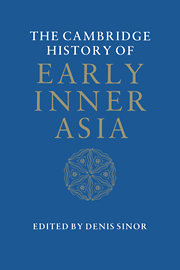Book contents
- Frontmatter
- 1 Introduction: the concept of Inner Asia
- 2 The geographic setting
- 3 Inner Asia at the dawn of history
- 4 The Scythians and Sarmatians
- 5 The Hsiung-nu
- 6 Indo-Europeans in Inner Asia
- 7 The Hun period
- 8 The Avars
- 9 The peoples of the Russian forest belt
- 10 The peoples of the south Russian steppes
- 11 The establishment and dissolution of the Türk empire
- 12 The Uighurs
- 13 The Karakhanids and early Islam
- 14 Early and medieval Tibet
- 15 The forest peoples of Manchuria: Kitans and Jurchens
- Bibliography
- Index
- References
8 - The Avars
Published online by Cambridge University Press: 28 March 2008
- Frontmatter
- 1 Introduction: the concept of Inner Asia
- 2 The geographic setting
- 3 Inner Asia at the dawn of history
- 4 The Scythians and Sarmatians
- 5 The Hsiung-nu
- 6 Indo-Europeans in Inner Asia
- 7 The Hun period
- 8 The Avars
- 9 The peoples of the Russian forest belt
- 10 The peoples of the south Russian steppes
- 11 The establishment and dissolution of the Türk empire
- 12 The Uighurs
- 13 The Karakhanids and early Islam
- 14 Early and medieval Tibet
- 15 The forest peoples of Manchuria: Kitans and Jurchens
- Bibliography
- Index
- References
Summary
The written sources
Although our sources concerning the Avars are rather poor and their historical interpretation is not beyond dispute, the clearest picture that can be drawn of the European destinies of the Avars must rely, above all, on the testimony of Greek and Latin and – to a smaller extent – on the evidence provided by Oriental (Syriac, Armenian, Coptic, Arabic) and Slavic sources. In spite of the fact that these sources view the Avars from the outside and represent a one-sided, Byzantine, Langobard or Frank point of view, they still constitute the most solid base for an approach to Avar history. There are no Avar records of any importance, and one must make do with such sources that are available. A survey of Avar history best begins with a conspectus of the main data culled from the available written sources.
As early as the 6th century B.C. a shaman-like wonderpriest called Abaris is known in the Hellenic tradition. It is however very questionable whether that name – supposedly a personal name of steppe origin – may be directly connected with the ethnic name of the Avars. The palimpsest of the Vatican, deciphered lately, seems to suggest the ethnonym “Aparnoi” which occurs in some manuscripts of Strabo may be a corrupted reading; and should not be considered a reference to the Avars. It is Priscus, chronicler of the great Eurasian migrations of about A.D. 463, who among the known Greek and Latin authors is the first to mention with certainty the name of the Avar people.
- Type
- Chapter
- Information
- The Cambridge History of Early Inner Asia , pp. 206 - 228Publisher: Cambridge University PressPrint publication year: 1990
References
- 12
- Cited by



